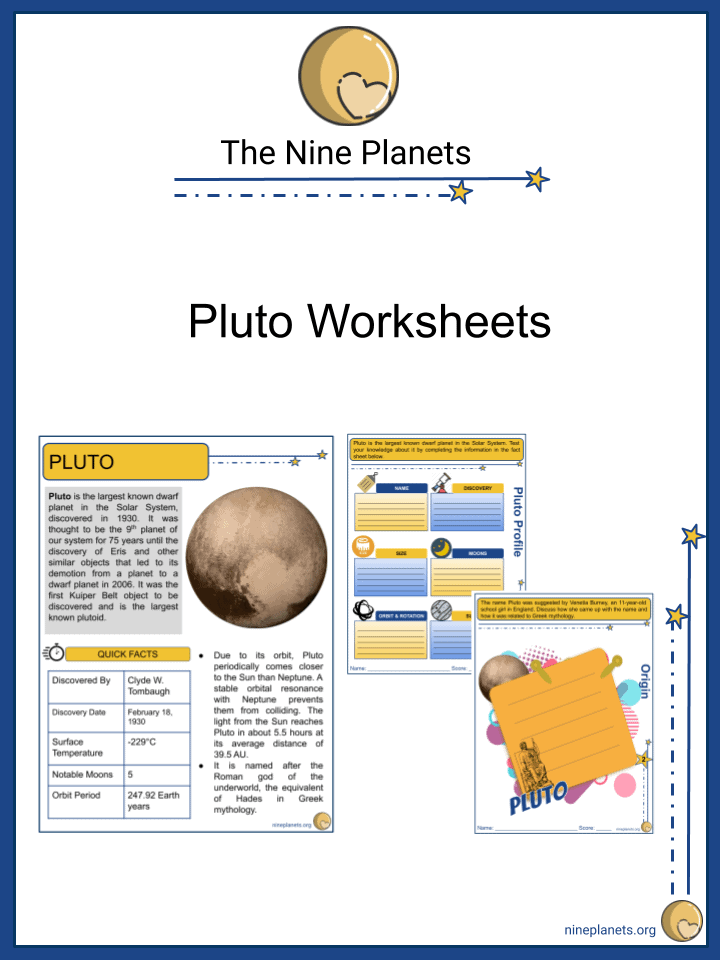Looking for fun activities to teach kids about the planet Pluto?
This premium worksheet bundle contains a printable fact file and 10 fun and engaging worksheets to challenge your students and help them learn about Pluto.
The planet Pluto is named after the Roman god of the underworld. In Greek mythology, he is known as Hades, ruler of the underworld. The planet was named after such a deity because it is very far away from the Sun, and thus in perpetual darkness.
Key Facts & Summary
- Pluto is the ninth-largest and tenth most massive known object directly orbiting the Sun.
- It is the first Kuiper Belt object to be discovered and it is the largest known plutoid.
- Pluto was discovered in 1930 by Clyde Tombaugh.
- Pluto was classified as a planet for 75 years. It held the title of the ninth planet of the Solar System.
- Pluto was declassified from the status of planet to that of a dwarf planet in 2006 after another dwarf planet, Eris was discovered.
- The controversial classification of Pluto forced the scientific community to come up with the definition of a planet.
- Pluto is primarily made out of ice and rock. It is relatively small even when compared to Earth’s Moon, being one-sixth of the moon’s mass, and one-third of its volume.
- Pluto has an unusual orbit that takes it closer to the Sun than the farthest planet Neptune, but also, it takes it farther from the Sun than Neptune’s position.
- Pluto has five known moons: Charon, Styx, Nix, Kerberos, and Hydra.
- Pluto’s moon Charon is the largest, having around half of Pluto’s diameter.
- Charon is the biggest known moon of any dwarf planet.
- Pluto has a radius of 1.185 kilometers / 737 miles, thus it is 1/6 the width of Earth and a diameter of 2.326 km / 1.445 mi.
- Pluto has mountains, valleys, and craters. The surface temperatures vary from -375 to – 400 degrees Fahrenheit / - 226 to – 240 degrees Celsius.
- Pluto is one third made out of water. Its atmosphere is very similar to that of a comet since it collapses as it moves away from the Sun, and expands as it gets close.
- Pluto doesn’t seem to have a magnetic field.
Pluto is usually farther away from the Sun than Neptune, but sometimes it comes closer. It is the smallest planet of the Solar System.
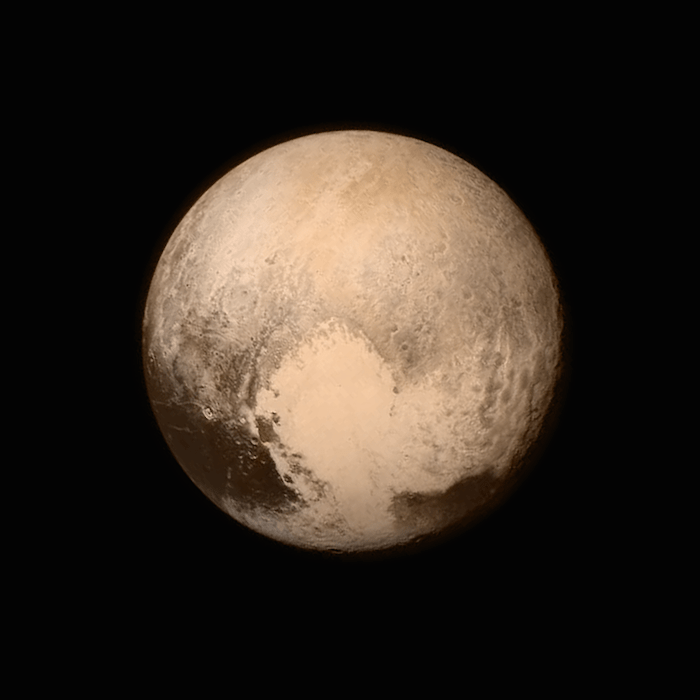
It is also smaller than seven of the Solar System’s moons. Today, Pluto isn’t considered a planet anymore, but rather a dwarf planet because of its size. It is though the largest among the dwarf planets.
However, many still consider Pluto a planet since the latest missions revealed a complex world. Whether you consider Pluto a planet or a dwarf planet is up to you!
Structure and Surface
Pluto is made out of primarily from nitrogen ice and rock. Its surface is covered with mountains, valleys, and craters. Its surface varies in both brightness and color.
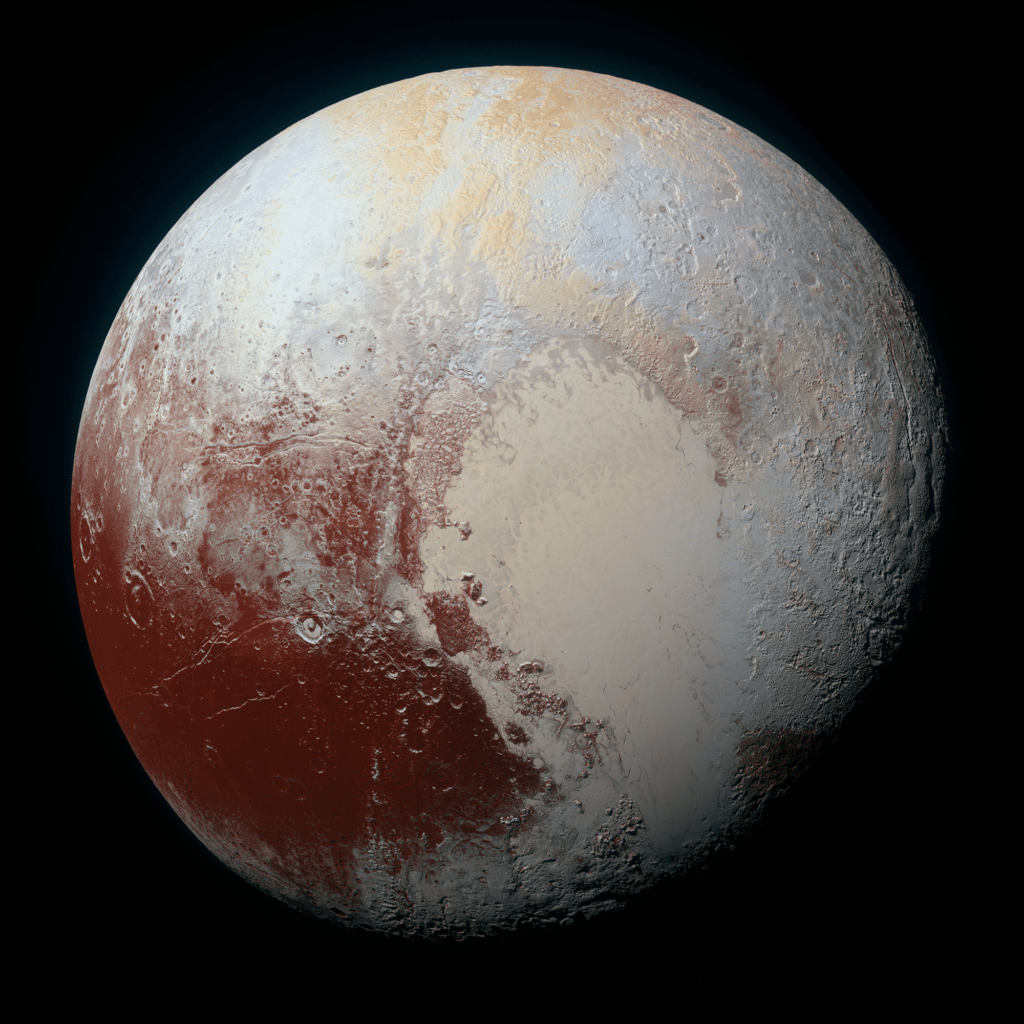
Some regions are charcoal black, dark orange, white, and has some portions of red similar to Mars. Some notable regions are:
- Tombaugh Regio, also known as the Heart –a large bright area.
- Chtulhu Macula, also known as the Whale – a large dark area.
- Brass knuckles – a series of dark areas located near the equator.
Scientists believe that Pluto has a dense core surrounded by a mantle of water ice. The atmosphere of Pluto is similar to a comet. It is thin, tenous, and expands when it comes closer to the Sun, but then it collapses as it moves farther away.
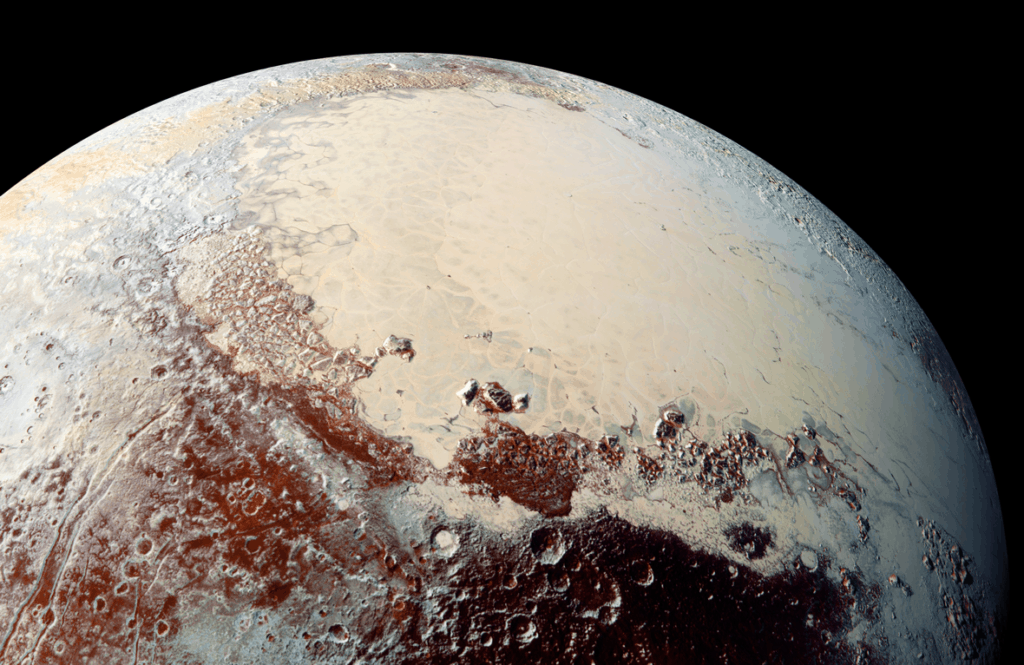
When Pluto approaches the Sun, the ices change from solid to gas, and they rise up temporarily to form a thin atmosphere. The tenuous atmosphere is consistent with nitrogen, methane, and carbon monoxide.
Time on Pluto
Pluto spins very slowly, and as such, one day there is equal to 153 hours. Since Pluto is so far away from the Sun, and because it has an unusual orbit, one trip around the Sun or a year, is completed within 248 Earth years.
Fun Facts
- Pluto was closer to the Sun than Neptune from 1979 to 1999.
- Tradition dictates that when a new planet is named, an element would be named after a variation of the planet's name. As such, plutonium was named after Pluto, uranium after Uranus, and neptunium after Neptune.
- Walt Disney named a canine companion of Mikey Mouse, Pluto.
- Pluto is the second closest dwarf planet to the Sun, first place is held by Eris.
- The distance between Pluto and its moon Charon, is about the same as from one side of South America to the last side of North America.
- Pluto’s second-largest moon Hydra, is 5.000 times fainter than Pluto.
- Pluto’s moon Charon is composed out of 55% rock and 45% ice. It has a reddish polar region that was dubbed Mordor – after the base of Sauron, the main villain of J.R.R. Tolkien’s Lord of the Rings.
- Charon is named after the ferryman of the dead in Greek mythology. Some consider Pluto/Charon a double planet rather than a planet and a moon.
- The surface area of Pluto is a bit bigger than Russia, or about half as wide as the United States.
- Pluto has more than twice the diameter of Ceres, the largest object in the asteroid belt, and it also has a dozen times its mass.
Size and Comparison
Pluto has a radius of 1.185 kilometers / 737 miles, thus it is 1/6 the width of Earth and a diameter of 2.326 km / 1.445 mi. It has 70% of the diameter of Earth’s Moon.

Mercury, the smallest planet of the Solar System, has more than twice the diameter of Pluto. In comparison to Jupiter, the largest planet of the Solar System, it has more than 60 times the diameter of Pluto.
Trivia
Naming Pluto
After Pluto was discovered, a survey was conducted to name the planet. Venetia Burney, an eleven-year-old schoolgirl in Oxford proposed the name, Pluto.
The name won by popular votes, and it was announced to the public on the 1st of May 1930. The little girl received a gift for naming the planet, a modern equivalent of 450 USD.
Pluto – Definition of a planet
Pluto’s declassification from a planet to that of a dwarf planet sparked many debates in the scientific community. It forced them to come up with a definition, and now we know that there are three requirements for a celestial body to be considered a planet:
- The object must orbit around the Sun – or any other star.
- It must be massive enough to be rounded by its own gravity.
- It must have cleared the neighborhood around its orbit.
Pluto failed to meet the third condition. Its mass is substantially less than the combined mass of the objects in its orbit.
Other Characteristics
Pluto periodically comes closer to the Sun than Neptune, but they will never collide. Pluto has five moons: Charon, Styx, Nix, Kerberos, and Hydra.
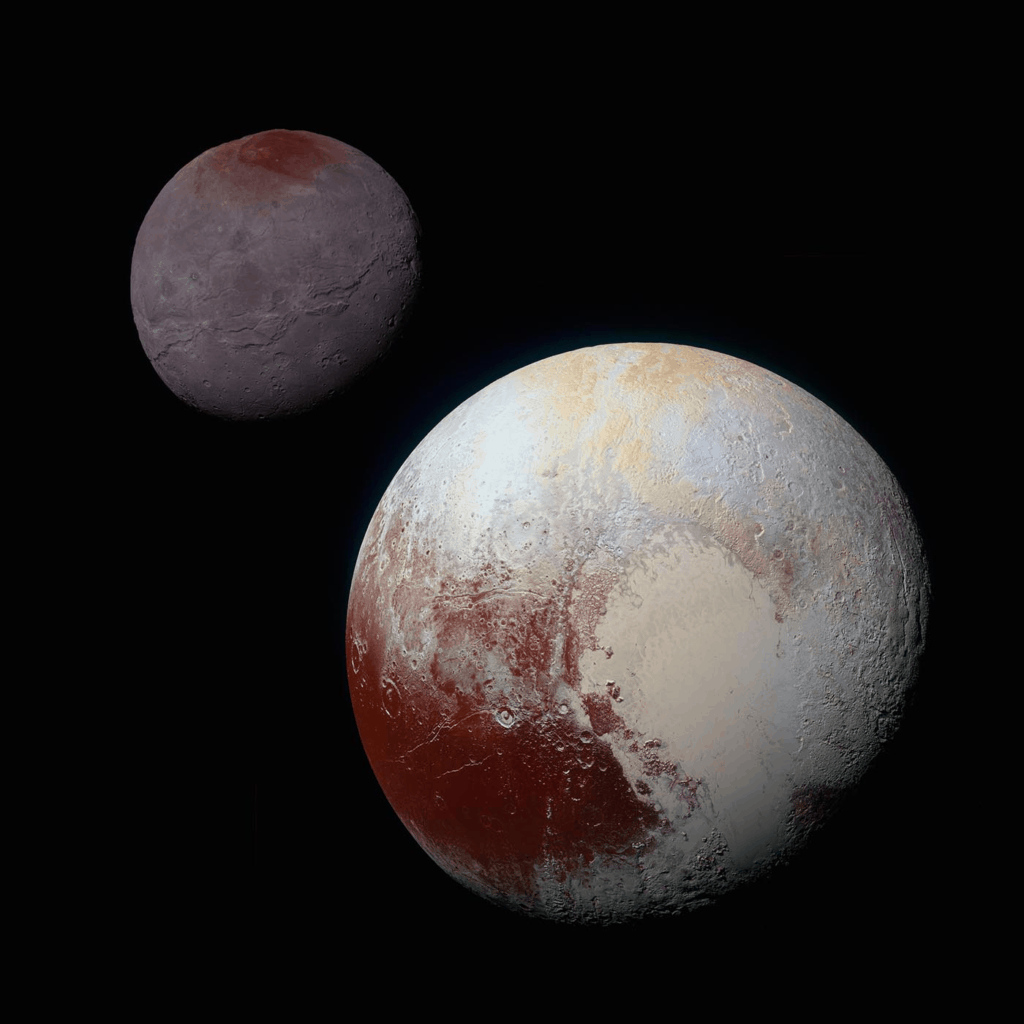
The moon Charon is the biggest known moon of a dwarf planet ever discovered. Charon is even bigger than the dwarf planet Eris. Pluto is the second closest dwarf planet to the Sun, second only to Eris.
Pluto Notes
- The first spacecraft to visit Pluto was NASA’s New Horizons. It arrived on Pluto in 2015 after a 9-year journey. The person who discovered Pluto had his remains placed aboard the spacecraft.
- Pluto is half the width of the United States. It is smaller than Earth’s Moon.
- Many people consider Pluto as a planet to this day, while the officials have declared that Pluto is a dwarf planet. Regardless of how you view Pluto, it surely is a beautiful world.
- Pluto is the farthest planet from the Sun, but it sometimes comes closer to the Sun than Neptune.
- We have yet to witness one Plutonian year since the planet was discovered in 1930 by Clyde Tombaugh, and one year on Pluto is 248 Earth years.
- Usually, the light from the Sun reaches Pluto in about 5.5 hours.
- Pluto is made up of ice and rock – it is one third made out of water basically.
- No further missions are currently planned for Pluto, but since the last one was a success, agencies will likely send more spacecraft towards the distant world.
Sources:
[1.] Wikipedia
[2.] NASA
Image sources:
- https://spaceplace.nasa.gov/review/ice-dwarf/pluto_new_horizons.en.png
- https://www.nasa.gov/sites/default/files/thumbnails/image/crop_p_color2_enhanced_release_small.png
- https://www.nasa.gov/sites/default/files/thumbnails/image/nh-pluto_crop.jpg.png
- https://cdn.mos.cms.futurecdn.net/rCdTVsPesASiv3JeVyhHsa-1200-80.jpg
- https://www.nasa.gov/sites/default/files/thumbnails/image/edu_what_is_pluto_1.png

